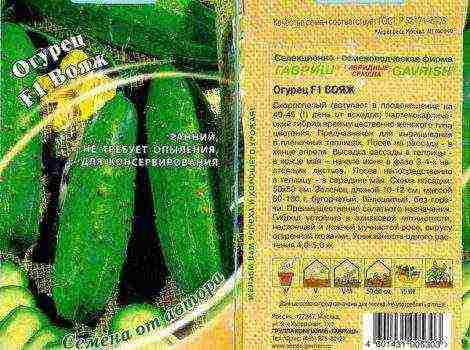Content
Read the content of the article!
Spring witch hazel: photo, description, planting and care. Spring witch hazel is an amazing plant that adorns the garden while the rest of its inhabitants are resting. That is, its very unusual and decorative flowers appear in early spring or even in winter, during the frost period. How to grow a shrub in your garden can be found in the article.
What is spring witch hazel
The most common bushes of spring witch hazel are found on the American continent and in eastern Asia. Here they have been successfully grown for a long time in gardens and parks. You can see it in some places of the Caucasus.
Witch hazel is popularly referred to as a magic nut, a witch's nut, a witch's nut. All these nicknames were given to the shrub in connection with the external resemblance to the nut (hazel) and the very unusual flowering times for plants.
Witch hazel looks like this:
- The crown of the bush is very spreading. In height, it can reach 5-6 m, in width 5-5.5 m.
- Petals are long (up to 10 mm), yellow. Some varieties of witch hazel have a different color.
- The color cups are dark red.

Adult witch hazel
- The general appearance of the witch hazel flower in the photo is very similar to the fringe gathered in a bunch.
- Leaves are oval, wide, rough to the touch. They are characterized by a great similarity with walnut leaf plates.
- The fruits of the shrub are boxes with interesting "horns". They ripen within six months or more.
Note! Witch hazel stands out for one interesting property - the petals of its flowers curl in cold weather.
Spring witch hazel blooms 5-7 years after planting. The buds on it can be seen at the end of April, when the leaves on the shrub have not yet blossomed. After 5 months (September-October) small green fruits appear.
Witch hazel grows very slowly (10-20 cm per year). Prolonged exposure to severe frosts in bushes growing in open ground can damage the shoots.
Varieties of spring witch hazel and shrub planting rules
A total of 4 plant species are known. Through the efforts of breeders, several varieties of the spring variety have been obtained.
- Sandra. Differs in unconventional, purple leaves. Moreover, only young specimens are painted this way. In the future, the plate on top turns green.
- Purpurea. This variety has burgundy inflorescences.
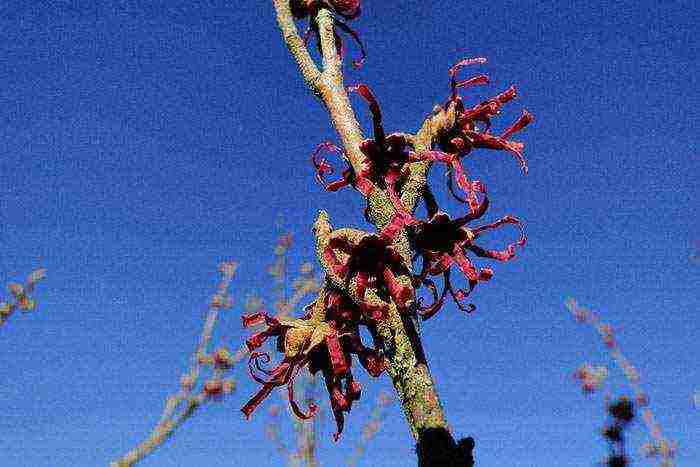
Purpurea cultivar
- Autumn Embers. The variety is endowed with a faded color of the petals.
- Squib. The variety is distinguished by yellow shoots and a green calyx of the flower.
- Lombarts Weeping. The flowers have an original shape.
- Christmas Cheer. The buds on the shoots of shrubs appear earlier than anyone else.
Planting witch hazel is not particularly difficult. The place planned for growing the plant can be either open or in light shade.
The most suitable soil for witch hazel is loam. This type of soil absorbs moisture well and retains it for a long time. The plant does not like calcareous rocks. In such soil, it does not grow and can quickly die.
Note! You can not plant a shrub in the sun. He does not tolerate extreme heat.
When planting, be sure to equip good drainage. For this, the bottom of the pit is covered with stones or expanded clay. Ensuring good water permeability will keep the roots from rotting.
The crop is planted either in early spring or late in autumn. They do it as follows:
- Dig a hole, which should be several times larger than an earthen lump on a seedling.
- A plant is installed in the center of the hole, the root is straightened and covered with a mixture of earth and humus.
- A little tamp the planting and watered well.
Useful advice! In order to fill the voids between the roots of the seedling well, after watering it must be gently pulled up and gently shaken.
After planting, the near-root zone is covered with a thick layer of hay or leaves. This will prevent the plant from dying in the winter.
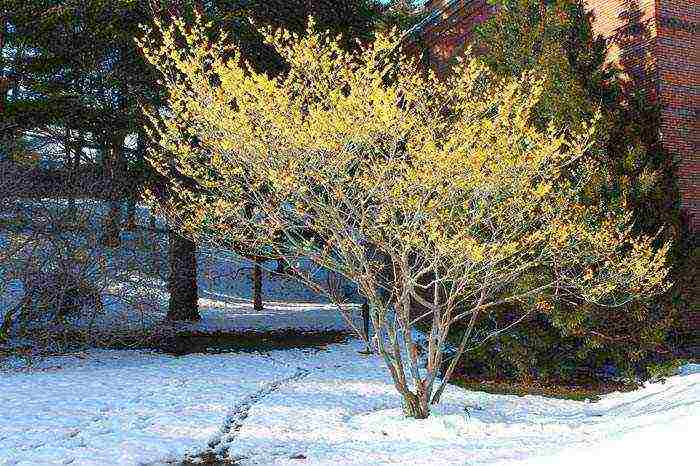
Caring for witch hazel and reproduction of exotic
Witch hazel cannot be called a whimsical plant, however, in order for the culture to feel good, some care rules must be followed.
- Watering is necessary when the soil around dries up. During dry periods, the shrub is greatly depleted, so it is advisable to irrigate the entire crown in the morning and evening.
- Periodically, it is required to loosen the ground at the roots of witch hazel.
- Shrub pruning is needed in case of strong crown thickening. Branches growing in an unnecessary direction are advised to be cut into a ring already in two-year-old seedlings. In the spring, sanitary pruning should be arranged, while removing frozen shoots.
- Up to 5 years, the plant should be provided with shelter for the winter. To do this, cover the ground around the trunk with hay or a thick layer of compost. This procedure will protect the roots from freezing.
Note! Hybrid forms tolerate low temperatures much worse than base types of witch hazel.
Due to the slow growth, the first buds can form on the plant after 5 or even 10 years. Only then will the bush be able to truly demonstrate its beauty.
How to propagate witch hazel
The ornamental shrub is propagated by seeds and cuttings. Hybrid forms do not lose their properties only when using the second option.
Cutting takes place like this:
- In the middle of summer, cuttings are harvested. For this, the tops of the shoots with 3-4 internodes are suitable.
- The material is immersed in a root stimulator for several hours.
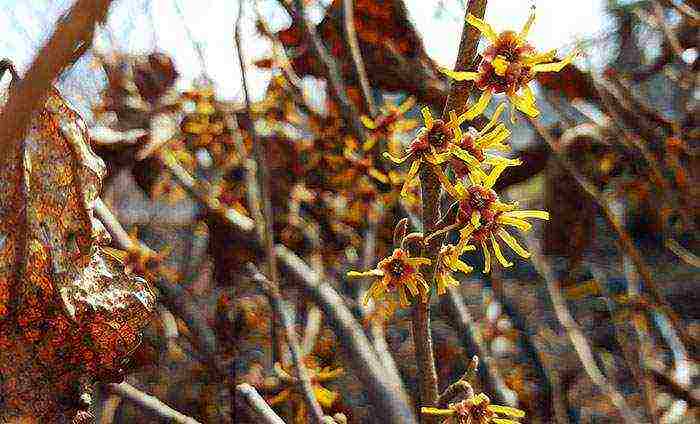
- At an angle of 45 °, the cuttings are inserted into a loose and nutritious substrate.
- Moistened with a spray bottle.
- Cover with foil and arrange in a warm, but not hot, shaded place.
- Roots appear after 4-6 weeks.
Witch hazel seeds are harvested in September-November and immediately start sowing. Boxes with crops are arranged for a cool winter in a room where the temperature does not drop below + 2 ° C.
Seed germination can only be expected in the second year at the beginning of spring. Seedlings are very tender and require special care. For a year, seedlings rise by 20 cm, no more.
Spring witch hazel can be called a valuable plant. It is used in medicine and cosmetology. Having planted this exotic on the site, amateurs acquire not only a beautiful shrub, but also the opportunity to improve their health and improve their appearance.
Witch hazel: video
Country house
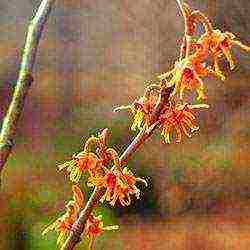 Spring witch hazel is an amazing plant that adorns the garden while the rest of its inhabitants are resting. That is, its very unusual and decorative flowers appear in early spring or even in winter, during the frost period. How to grow a shrub in your garden can be found in the article.
Spring witch hazel is an amazing plant that adorns the garden while the rest of its inhabitants are resting. That is, its very unusual and decorative flowers appear in early spring or even in winter, during the frost period. How to grow a shrub in your garden can be found in the article.
What is witch hazel
The most common bushes of spring witch hazel are found on the American continent and in eastern Asia. Here they have been successfully grown for a long time in gardens and parks. You can see it in some places of the Caucasus.
Witch hazel is popularly called witch hazel, witch's nut, witch's nut. All these nicknames were given to the shrub in connection with the external resemblance to the nut (hazel) and the very unusual flowering times for plants.
Witch hazel looks like this:
- The crown of the bush is very spreading. In height, it can reach 5-6 m, in width 5-5.5 m.
- Petals are long (up to 10 mm), yellow. Some varieties of witch hazel have a different color.
- The color cups are dark red.

Adult witch hazel
- The general appearance of the witch hazel flower in the photo is very similar to the fringe gathered in a bunch.
- Leaves are oval, wide, rough to the touch. They are characterized by a great similarity with walnut leaf plates.
- The fruits of the shrub are boxes with interesting "horns". They ripen within six months or more.
Attention! Witch hazel stands out for one interesting property - the petals of its flowers curl in cold weather.
Spring witch hazel blooms 5-7 years after planting. The buds on it can be seen at the end of April, when the leaves on the shrub have not yet blossomed. After 5 months (September-October) small green fruits appear.
Witch hazel grows very slowly (10-20 cm per year). Prolonged exposure to severe frosts in bushes growing in open ground can damage the shoots.
Varieties of spring witch hazel and shrub planting rules
A total of 4 plant species are known. Through the efforts of breeders, several varieties of the spring variety have been obtained.
- Sandra. Differs in unconventional, purple leaves. Moreover, only young specimens are painted this way. In the future, the plate on top turns green.
- Purpurea. This variety has burgundy inflorescences.

Purpurea cultivar
- Autumn Embers. The variety is endowed with a faded color of the petals.
- Squib. The variety is distinguished by yellow shoots and a green calyx of the flower.
- Lombarts Weeping. The flowers have an original shape.
- Christmas Cheer. The buds on the shoots of shrubs appear earlier than anyone else.
Planting witch hazel is not particularly difficult. The place planned for growing the plant can be either open or lightly shaded.
Attention! You can not plant a shrub in the sun. He does not tolerate extreme heat.
The most suitable soil for witch hazel is loam. This type of soil absorbs moisture well and retains it for a long time. The plant does not like calcareous rocks. In such soil, it does not grow and can quickly die.
When planting, be sure to equip good drainage. For this, the bottom of the pit is covered with stones or expanded clay. Ensuring good water permeability will prevent the roots from rotting.
The crop is planted either in early spring or late in autumn. They do it as follows:
- Dig a hole, which should be several times larger than an earthen lump on a seedling.
- A plant is placed in the center of the hole, the root is straightened and covered with a mixture of earth and humus.
- A little tamp the planting and watered well.
Advice. In order to fill the voids between the roots of the seedling well, after watering it must be gently pulled up and gently shaken.
After planting, the near-root zone is covered with a thick layer of hay or leaves. This will prevent the plant from dying in the winter.

Caring for witch hazel and reproduction of exotic
Witch hazel cannot be called a whimsical plant, however, in order for the culture to feel good, some care rules must be followed.
- Watering is necessary when the soil around dries up. During dry periods, the shrub is greatly depleted, so it is advisable to irrigate the entire crown in the morning and evening.
- Periodically, it is required to loosen the ground at the roots of witch hazel.
- Shrub pruning is needed in case of strong crown thickening. Branches growing in an unnecessary direction are advised to be cut into a ring already in two-year-old seedlings. In the spring, sanitary pruning should be arranged, while removing frozen shoots.
- Up to 5 years, the plant should be provided with shelter for the winter. To do this, cover the ground around the trunk with hay or a thick layer of compost. This procedure will protect the roots from freezing.
Attention! Hybrid forms tolerate low temperatures much worse than base types of witch hazel.
Due to the slow growth, the first buds can form on the plant after 5 or even 10 years. Only then will the bush be able to truly demonstrate its beauty.
How to propagate witch hazel
The ornamental shrub is propagated by seeds and cuttings. Hybrid forms do not lose their properties only when using the second option.
Cutting takes place like this:
- In the middle of summer, cuttings are harvested. For this, the tops of the shoots with 3-4 internodes are suitable.
- The material is immersed in a root stimulator for several hours.

- At an angle of 45 °, the cuttings are inserted into a loose and nutritious substrate.
- Moistened with a spray bottle.
- Cover with foil and arrange in a warm, but not hot, shaded place.
- Roots appear after 4-6 weeks.
Witch hazel seeds are harvested in September-November and immediately start sowing. Seed boxes are arranged for a cool winter in a room where the temperature does not drop below + 2 ° C.
Seed germination can only be expected in the second year at the beginning of spring. Seedlings are very tender and require special care. For a year, seedlings rise by 20 cm, no more.
Spring witch hazel can be called a valuable plant. It is used in medicine and cosmetology. Having planted this exotic on the site, amateurs acquire not only a beautiful shrub, but also the opportunity to improve their health and improve their appearance.
Witch hazel: video
The characteristic spider-like flowers of witch hazel, painted in bright tones of yellow, red and orange, adorn the garden in early spring, when the look is already tired of the winter monotony and requires fresh colors. The flowers are usually about 3 cm in diameter, composed of curved, belt-like petals about 1.5 cm long. These unusual flowers, collected in inflorescences, appear on leafless branches and survive severe frosts. The flowers of most plants have at least a faint scent.
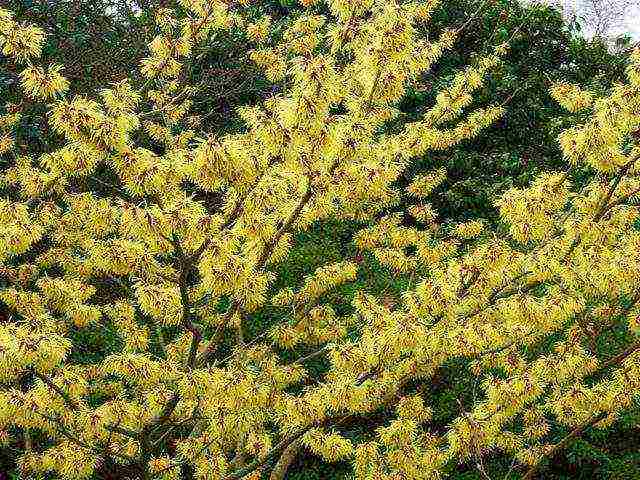 Witch hazel
Witch hazel
Another reason to grow witch hazel is the colorful fall foliage painted in fiery hues. Leaves are finely toothed, pubescent, usually ovoid or nearly round, up to 10 cm long and almost the same width.
These slow-growing, medium-sized to large deciduous shrubs often grow as wide as in height. Give them enough space and they become some of the best plants in the garden. Homeland - the east of North America and Asia.
Recommended species and varieties
N. intermedia (G. intermediate)
Flowers appear on bare branches in the earliest spring. The plant is variable. The original species is rarely grown, as numerous varieties are preferred to it. Plant height and diameter - 1x1 m (5 years). The maximum height is 4 m.
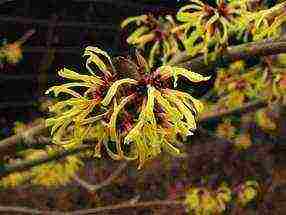 Variable plant
Variable plant
Hedera
The varieties reliably retain the color of the flowers, but are usually shorter than the parental species.
 Hedera
Hedera
Arnold Promise
Numerous bright yellow flowers and yellow autumn foliage.
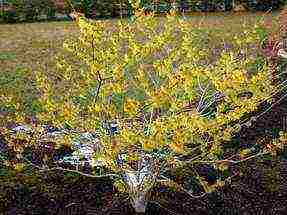 Numerous bright yellow flowers
Numerous bright yellow flowers
"Diane"
The best of the red-flowered varieties. Leaves turn bright red in autumn.
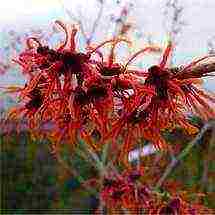 Variety with red flowers
Variety with red flowers
"Jelena"
The variety has yellow flowers with a copper-red tint, so that from a distance they appear orange. Autumn leaves glow with red, orange and bright red colors.
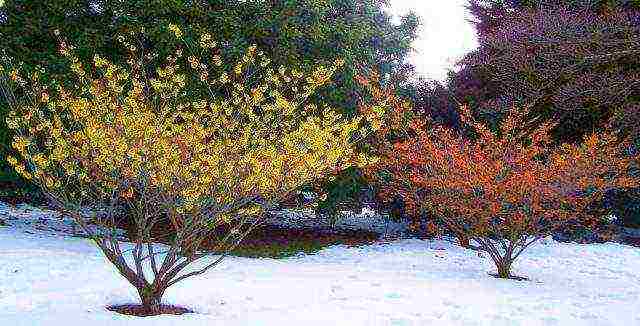 The variety has yellow flowers with a copper-red tint.
The variety has yellow flowers with a copper-red tint.
"Ruby Glow"
Variety with copper-red flowers and reddish fall foliage.
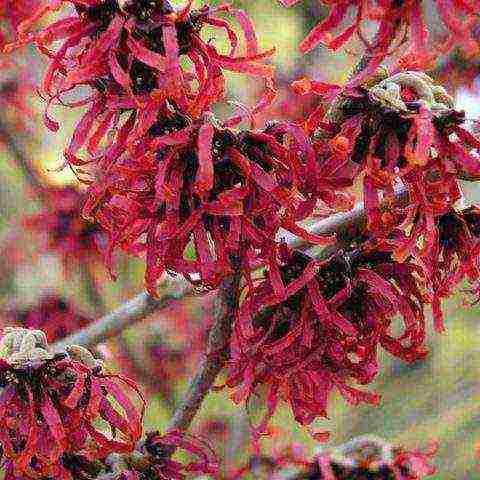 Variety with copper-red flowers
Variety with copper-red flowers
Japonica (G. Japanese)
Swirling yellow flowers appear in early spring. Leaves are oval. Plant height and diameter - 1x1 m (5 Years). The maximum height is 3 m.
 Swirling yellow flowers
Swirling yellow flowers
"Zuccariniana"
Flowers with a lighter yellow color appear a little later than in the parental species. The plant is large, reaching a size of 2x1.2 m at the age of five years, with a maximum height of 4 m or more and almost the same diameter. Leaves are oval, turn yellow in autumn.
 Flowers with a lighter yellow color
Flowers with a lighter yellow color
N. mollis (G. soft, Chinese witch nut)
This plant is arguably the most beautiful of all. Many small, golden-yellow flowers, collected in inflorescences, appear in early spring. The aroma is strong and pleasant. Leaves are round, up to 12.5 cm long and almost the same diameter, turn yellow in autumn. The height and diameter of the plant is 1.2x1.2 m (5 years). The maximum height is 4 m.
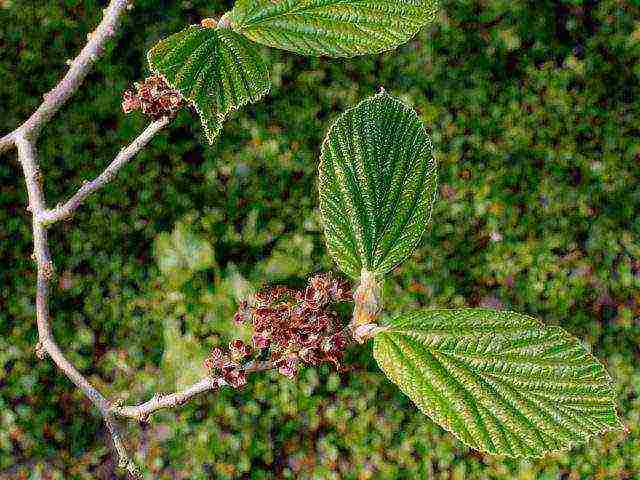 The aroma is strong, pleasant
The aroma is strong, pleasant
"Pallida" (syn. N. intermedia "Pallida")
Variety very early forms a lot of light sulfur-yellow flowers with a strong aroma. Leaves turn dark yellow in autumn.
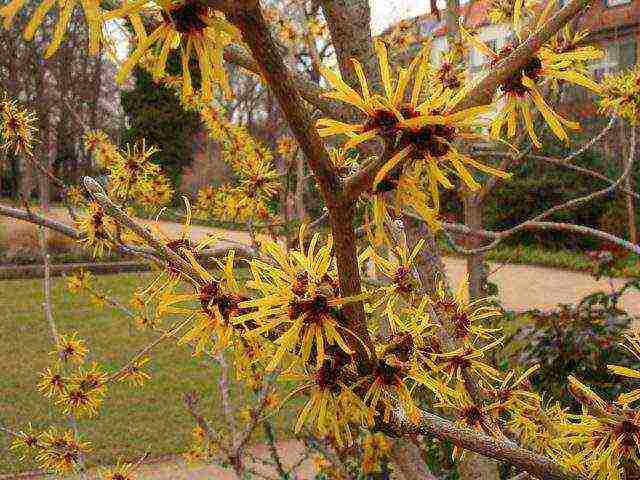 Light yellow flowers
Light yellow flowers
J. vernalis "Sandra" (G. spring, Ozark magic nut)
The flowers are light yellow, appear from mid-winter to mid-spring.When unrolled, leaves with a plum-purple hue that fades gradually during the summer months. The bushes look very attractive in the fall, turning orange, purple and red. The height and diameter of the plant is 80x80 cm (5 years). Maximum height -2 m.
 The bushes look very attractive in autumn.
The bushes look very attractive in autumn.
Growing
In the middle zone of the European part of Russia, of the described species, only spring witch hazel can be grown, the rest of the species do not hibernate. Plants are planted in well-drained neutral or acidic soil.
Reproduction
Hard, shiny black seeds are sown from early to mid-spring. Germination lasts for two years.
If a particular trait needs to be preserved, vaccinations are necessary, although layering may also be successful.
Pruning
Usually not required, except for the removal of dead shoots in autumn and winter.
Pests and diseases
Usually not affected.
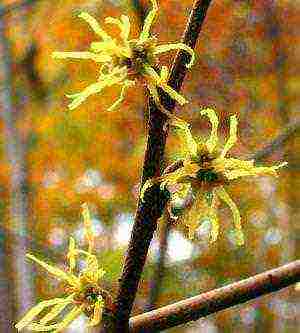 Witch hazel is one of the most amazing plants in this world. The genus witch hazel cannot boast of a great variety - only 4 species. Two of them live in North America, while the other two were born in East Asia. This plant was introduced into cultivation at the beginning of the 20th century, and is still very valuable.
Witch hazel is one of the most amazing plants in this world. The genus witch hazel cannot boast of a great variety - only 4 species. Two of them live in North America, while the other two were born in East Asia. This plant was introduced into cultivation at the beginning of the 20th century, and is still very valuable.
During flowering, witch hazel is almost completely covered with bright yellow flowers, which have narrow petals and purple dust particles. Not only flowers with long, twisted petals are unusual in a plant, but even the rhythm of development of its individual species. The fruits of witch hazel are woody, rounded bolls that outwardly resemble "nuts". The shrub grows at a very unusual time: either in early spring, or in the fall before the first frosts. In connection with this unusual property, it was also nicknamed the "magic nut".
Witch hazel has dense dark green and very beautiful obovate leaves, which have clearly defined veins. In warm autumn, they take on a lemon yellow color.
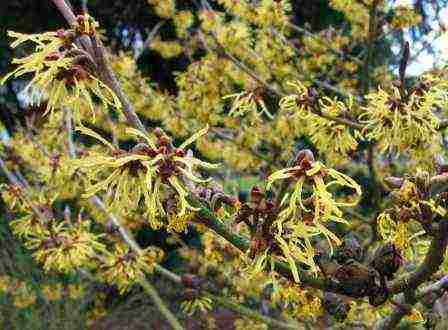
It is the American plant species that are most resistant to frost and temperate climates, and therefore it is they that are used for cultivation in Central Russia. Not susceptible to attacks by diseases and pests. In nature, both species are found on the territory of the eastern part of North America in the undergrowth of forests, on the edges, near streams, along the rocky banks of rivers and river valleys.
Also read: Presentable Gold Star juniper for a summer cottage
Material content
- 1 Spring witch hazel - spring blooming species
- 2 Hamamelis virginiana
- 3 Asian witch hazel
- 4 Cultivation and reproduction
- 5 Such a different witch hazel (video)
- 6 Application of witch hazel
Spring witch hazel - spring blooming species
Flowers of this plant species appear in mid-April, while the leaves have not yet been opened. The light yellow petals of the flower reach 1 cm in length, and look out a little from the calyx of a dark red hue. After the end of flowering, obovate or oval leaves appear on the bush. In September, the green capsule fruits become noticeable. The plant begins to bloom and bear fruit at the age of 5-7 years. The shrub perfectly tolerates both light and partial shade in a good place protected by tall trees. It is unpretentious to soil conditions. Witch hazel grows rather slowly, and the annual growth of shoots is also small, rarely reaching 10-20 cm.

As a cultivated plant, this species has been cultivated since 1908. In severe frosts in central Russia, annual shoots of the plant can be damaged, but everything quickly recovers due to the young growth. Due to this, witch hazel is more commonly grown in the southern regions.
Recommended for single plantings and small groups on the banks of water bodies.
Hamamelis virginiana
It is a multi-stemmed shrub 3 meters high with a rounded and wide crown, as well as with spreading branches. Young shoots are covered with stellate pubescence.In mid-May, dense, dark green leaves appear, characterized by an asymmetrical base, a jagged edge. They have gentle petioles, which are slightly pubescent at the bottom. But the most mysterious and interesting effect can be observed in the fall. In the middle of this month, a lot of flowers appear on the bush, which are collected in groups. Small, with 4 narrow petals and purple dust particles, slightly fragrant. The flower's calyx has a brownish-yellow tint. The shrub itself begins to bloom from 8-10 years of age within three weeks. In autumn, the shrub is very beautiful, thanks to its bright, yellow-lemon or slightly reddening leaves.
This species has been cultivated since 1736. In Russia, it is found mainly only in botanical gardens, but for gardeners it is a very rare plant.
One of the garden forms - Rubescens has a yellow-brown flower cup and red leaves. At the same time, the shrub is very suitable for mass use for both group and single plantings.
Asian witch hazel
The Asian species of this plant are bright and attractive: Japanese witch hazel and soft-haired witch hazel (Japan, Central China). Both plants have fragrant flowers, which consist of 4 narrow petals ranging from reddish to light lemon shades. From the flowers, stamens with bright carmine dust are visible. Intermediate witch hazel is especially elegant, which is the result of mixing these two species. All types of oriental plant species are recommended for planting in the southern regions of Russia.

Cultivation and reproduction
For planting shrubs, it is best to choose an open area, or a little shaded by the crowns of large trees. The plant needs light, fertile soil with drainage and abundant moisture. During drought, witch hazel requires good irrigation. Does not need pruning.
The shrub can be propagated using freshly harvested seeds, which are cold stratified. It is necessary to sow seeds in October-November in boxes that need to be covered with spruce branches or sawdust. In winter, boxes should be kept at a temperature of + 2-5 degrees Celsius in a cold greenhouse or buried in the snow. The first shoots will sprout in the spring, but only a year after sowing.
Such a different witch hazel (video)
Application of witch hazel
The plant's young shoots, bark and leaves contain an essential oil often used to make balms, lotions, and creams. Hemostatic extracts are made from the bark of the bush. Previously, an infusion of witch hazel leaves was used by Indian tribes as an external anti-inflammatory agent.
Attention, only TODAY!
Reviews and comments
Did you find a mistake in the text? Please select it and press Ctrl + Enter. Thank you!
Rating:
(
estimates, average:
out of 5)

